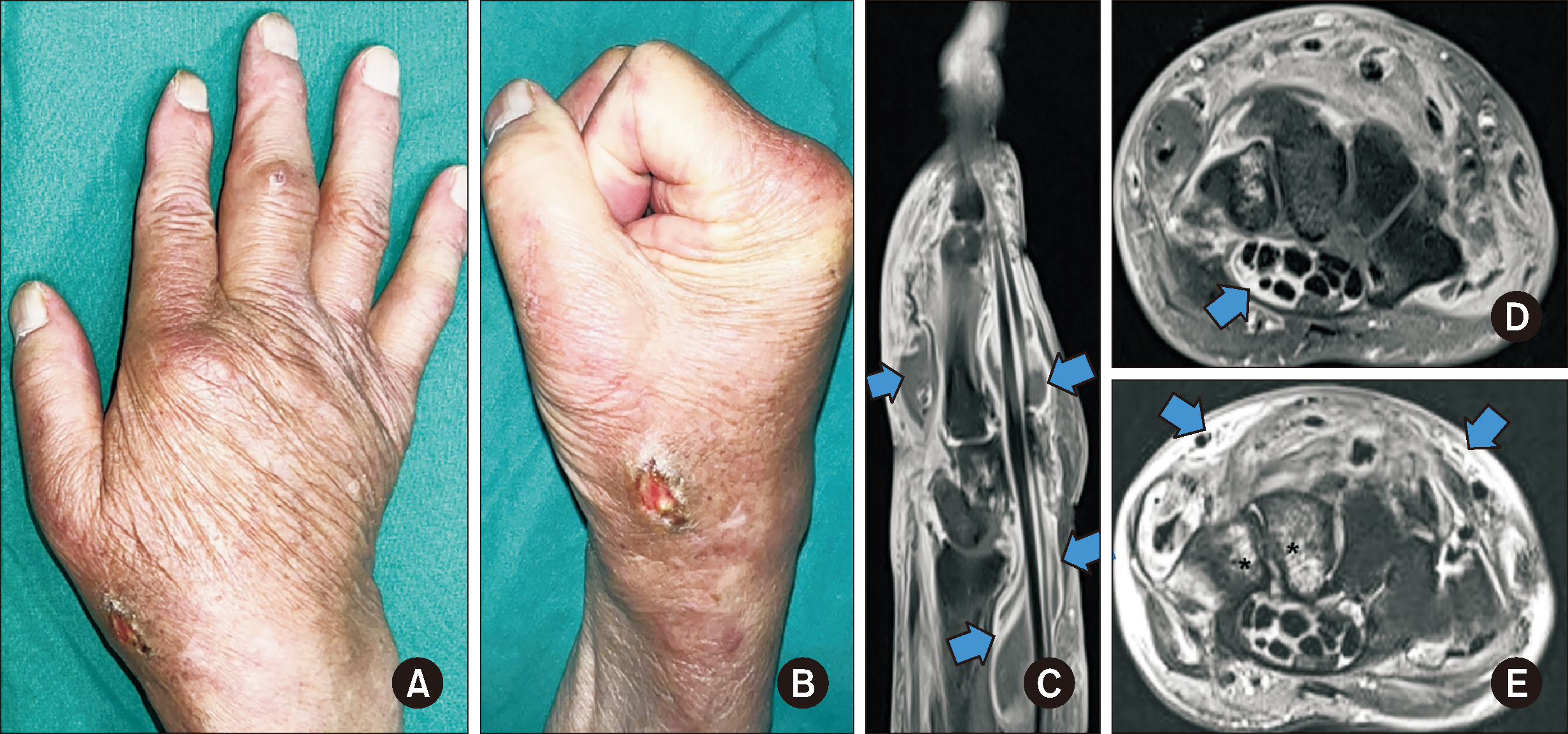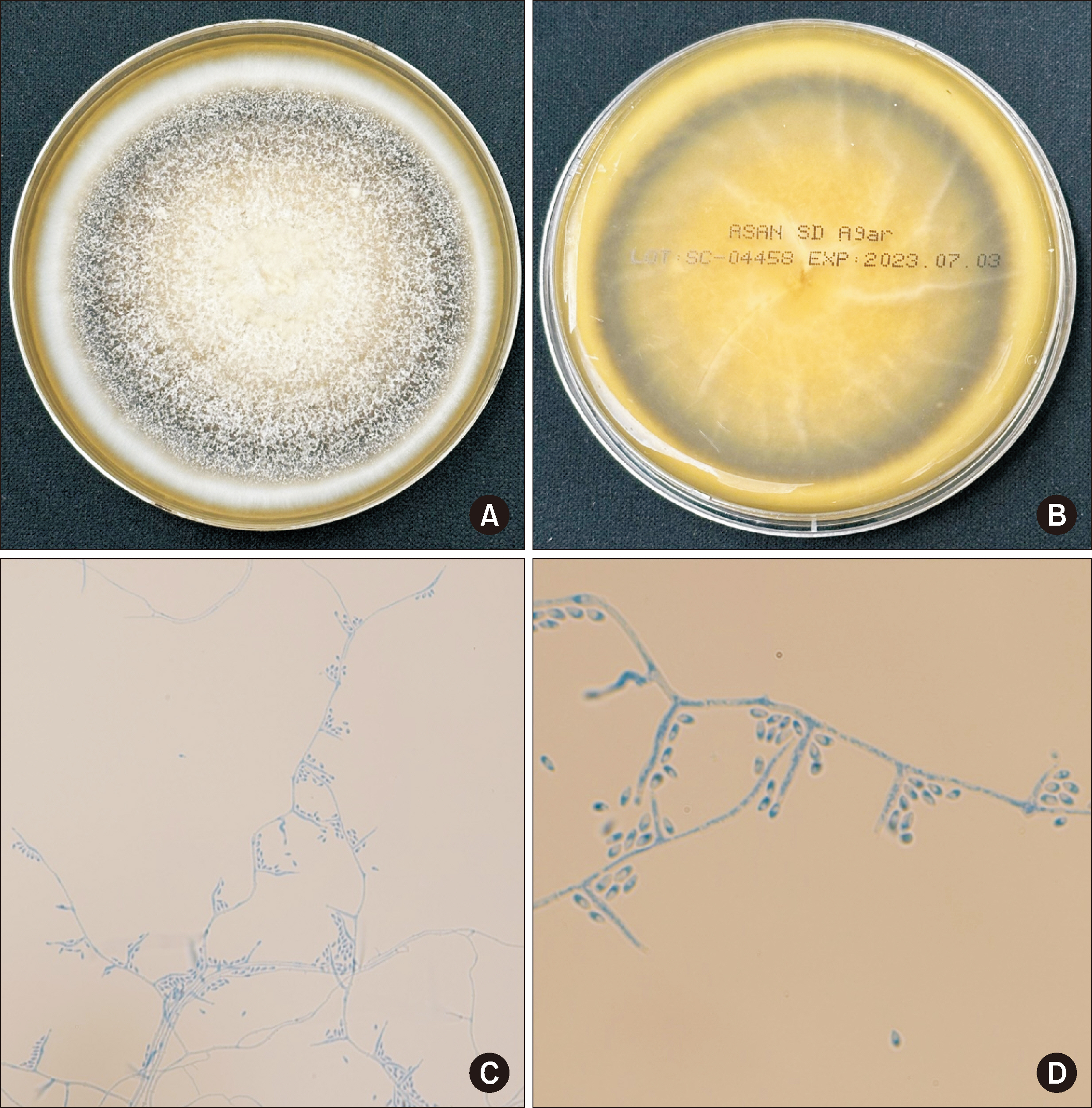Ann Lab Med.
2024 Nov;44(6):604-607. 10.3343/alm.2024.0068.
The First Case of Tenosynovitis Caused by Thyridium endophyticum
- Affiliations
-
- 1Department of Laboratory Medicine, Chonnam National University Hospital, Chonnam National University Medical School, Gwangju, Korea
- 2Department of Laboratory Medicine, Chonnam National University Bitgoeul Hospital, Chonnam National University Medical School, Gwangju, Korea
- 3Department of Radiology, Chonnam National University Hwasun Hospital, Chonnam National University Medical School, Hwasun, Korea
- 4Department of Orthopedic Surgery, Chonnam National University Hospital, Chonnam National University Medical School, Gwangju, Korea
- 5Division of Infectious Disease, Department of Internal Medicine, Chonnam National University Medical School, Hwasun, Korea
- KMID: 2560811
- DOI: http://doi.org/10.3343/alm.2024.0068
Figure
Reference
-
References
1. Perdomo H, García D, Gené J, Cano J, Sutton DA, Summerbell R, et al. 2013; Phialemoniopsis, a new genus of Sordariomycetes, and new species of Phialemonium and Lecythophora. Mycologia. 105:398–421. DOI: 10.3852/12-137. PMID: 23099515.2. Sugita R, Tanaka K. 2022; Thyridium revised: synonymisation of Phialemoniopsis under Thyridium and establishment of a new order, Thyridiales. MycoKeys. 86:147–76. DOI: 10.3897/mycokeys.86.78989. PMID: 35145340. PMCID: PMC8825628. PMID: 37ccf211b34b41118d266bd3c64a504a.3. Su L, Deng H, Niu YC. 2016; Phialemoniopsis endophytica sp. nov., a new species of endophytic fungi from Luffa cylindrica in Henan, China. Mycol Progress. 15:48. DOI: 10.1007/s11557-016-1189-5.4. Ito A, Yamada N, Kimura R, Tanaka N, Kurai J, Anzawa K, et al. 2017; Concurrent double fungal infections of the skin caused by Phialemoniopsis endophytica and Exophiala jeanselmei in a patient with microscopic polyangiitis. Acta Derm Venereol. 97:1142–4. DOI: 10.2340/00015555-2734. PMID: 28654130. PMID: 2d2dd51b1fdd49b283aa42100c913999.5. Rivero M, Hidalgo A, Alastruey-Izquierdo A, Cía M, Torroba L, Rodríguez-Tudela JL. 2009; Infections due to Phialemonium species: case report and review. Med Mycol. 47:766–74. DOI: 10.3109/13693780902822800. PMID: 19888810.6. Tang M, Li J, Xia F, Min C, Liu Z, Hu Y, et al. 2022; Acute post-cataract endophthalmitis due to Phialemoniopsis curvata: a rare case report. Infect Drug Resist. 15:1651–7. DOI: 10.2147/IDR.S359481. PMID: 35422644. PMCID: PMC9004724.7. Desoubeaux G, García D, Bailly E, Augereau O, Bacle G, De Muret A, et al. 2014; Subcutaneous phaeohyphomycosis due to Phialemoniopsis ocularis successfully treated by voriconazole. Med Mycol Case Rep. 5:4–8. DOI: 10.1016/j.mmcr.2014.04.001. PMID: 24936402. PMCID: PMC4052356. PMID: b3a14ce58d434dc2b496645f87338152.8. Alvarez Martinez D, Alberto C, Riat A, Schuhler C, Valladares P, Ninet B, et al. 2021; Phialemoniopsis limonesiae sp. nov. causing cutaneous phaeohyphomycosis in an immunosuppressed woman. Emerg Microbes Infect. 10:400–6. DOI: 10.1080/22221751.2021.1892458. PMID: 33634736. PMCID: PMC7946049. PMID: 3c93faee05954e6b85b40ea30f64afdd.9. Tsang CC, Chan JF, Ip PP, Ngan AH, Chen JH, Lau SK, et al. 2014; Subcutaneous phaeohyphomycotic nodule due to Phialemoniopsis hongkongensis sp. nov. J Clin Microbiol. 52:3280–9. DOI: 10.1128/JCM.01592-14. PMID: 24966363. PMCID: PMC4313151.10. Patolia H, Bansal E. 2021; Two rare cases of fungal bursitis due to Phialemoniopsis pluriloculosa. IDCases. 24:e01095. DOI: 10.1016/j.idcr.2021.e01095. PMID: 33898253. PMCID: PMC8055602.
- Full Text Links
- Actions
-
Cited
- CITED
-
- Close
- Share
- Similar articles
-
- Tuberculous Tenosynovitis of Hand (A Case Report)
- Marjolin's Ulcer Secondary to Tuberculous Tenosynovitis of the Wrist: A Case Report
- Tuberculous Tenosynovitis: A case report
- A case report of tuberculous tenosynovitis
- Operative Treatment of Stenosing Tenosynovitis of the Peroneus Longus Tendon Associated with Hypertrophy of the Peroneal Tubercle: A Case Report - 1 Case



